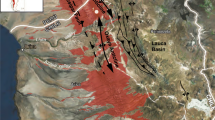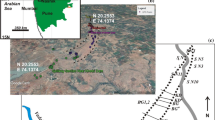Abstract
This study concludes that the elongation axis (K 1) of the ellipsoid of anisotropic magnetic susceptibility (AMS) is a suitable proxy for flow axis in ashflow tuffs. 153 oriented samples (176 specimens) were studied from 18 sites in the 1.1 Ma Tshirege member of the Bandelier Tuff. These sites are distributed around the Valles caldera at distances of 5–25 km outside of the rim.K 1 axes correlate well with postulated radial flow axes at 13 sites.K 1 also agrees with measured geological flow indicators, mainly imbricated larger clasts, at 7 sites. At 2 of the 5 sites where significant disagreement is seen between theoretical radial flow directions and measuredK 1 axes, theK 1 axes correspond well with geological flow indicators, indicating that the divergence of flow from the predicted radial flow pattern is real. Two major topographic buttresses are suggested as the cause of flow divergence for the Tshirege ash flows: the San Pedro buttress northwest of the caldera, and the San Miguel buttress in the southeast. In situK 1 axes plunge about 7° toward the source at two-thirds of the sites; therefore the plunge ofK 1 is a plausible in situ indicator for thedirection of flow. Multiple flow zones in sections of several meters thickness indicate changes of flow direction that are both rapid and large during ash-flow emplacement. These observations raisre the question of how best to represent ‘mean’ flow directions in ash-flow sheets: by eigenvector methods, by vector-sum methods, or by modes. A method for measuring imbrication of larger clasts using apparent dips in vertical joints is outlined. Imbrication, determined in this way at one-third of the sites, dips toward the source, i.e., up-flow. The minimum (K 3) axis of the AMS ellipsoid correlates with the flow foliation rather than with the larger clast imbrication. The flow axes of ash flows correspond with theK 1 axes, not with the declination ofK 3 axes as suggested by some authors. Initial dip of the sampled ash flows is not large and does not affect the paleomagnetic remanence direction, which is reversed with a mean ofD=173.5°,I=-38.4°, α95=3.4°N=18. This mean is not different at the 95% confidence level from that of earlier workers. The mean pole, at 098.0°E, 74.8°N,A 95=3.3°,N=18, is about 15° far-sided relative to the expected time-averaged geomagnetic pole, suggesting a history of emplacement too short to adequately average secular variation.
Similar content being viewed by others
References
Bailey RC, Halls HC (1984) Estimates of confidence in paleomagnetic directions derived from mixed remagnetization circle and direct observational data. J Geophys 54:174–182
Bailey RA, Smith RL, Ross CS (1969) Stratigraphic nomenclature of volcanic rocks in the jemez Mountains, New Mexico. US Geol Surv Bull 1274:1–19
Borradaile GJ (1988) Magnetic susceptibility, petrofabrics and strain. Tectonophysics 156:1–20
Buesch DC, Valentine GA (1989) Thickness and flow dynamics as factors controlling welding variations in ignimbrites. New Mexico Bureau of Mines and Mineral Resources Bull 131:32
Doell RR, Dalrymple GB, Smith, RL, Bailey RA (1968) Paleomagnetism, potassium-argon ages, and geology of rhyolites and associated rocks of the Valles caldera, New Mexico. Geol Soc Am Mem 116:211–248
Ellwood BB (1982) Estimates of flow direction for calc-alkaline welded tuffs and paleomagnetic data reliability from anisotropy of magnetic susceptibility measurements: central San Juan Mountains, southwest Colorado. Earth Planet Sci Lett 59:303–314
Elston WE, Smith EI (1970) Determination of flow direction of rhyolitic ash-flow tuffs from fluidal textures. Geol Soc Am Bull 81:3393–3406
Fisher RA (1953) Dispersion on a sphere. Proc R Soc London Ser A 217:295–305
Friedman I, Long W, Smith RL (1963) Viscosity and water content of rhyolite glass. J Geophys Res 68:6523–6535
Froggatt PC, Lamarche G (1989) Determination of flow direction and vent positions in Whakamaru Ignimbrite using anisotropy of magnetic susceptibility. New Mexico Bureau of Mines and Mineral Resources Bull 131:99
Gardner JN, Goff F, Garcia S, Hogan R (1986) Stratigraphic relations and lithologic variations in the Jemez volcanic field, New Mexico. J Geophys Res 91:1763–1778
Graham JW (1954) Magnetic susceptibility, an unexploited element of petrofabric. Geol Soc Am Bull 65:1257–1258
Hickson CJ, Hickson P, Barnes WC (1982) Weighted vector analysis applied to surge deposits from the May 18, 1980 eruption of Mount St. Helens, Washington. Can J Earth Sci 19:829–836
Hillhouse JW, Wells RE (1989) Magnetic fabric and source area of the Lower Miocene Peach Springs Tuff in Calif., Nevada, and Arizona. EOS, Transactions, Am Geophys Union 70:1067
Hirt AM, Lowrie W, Clendenen WS, Kligfield R (1988) The correlation of magnetic anisotropy with strain in the Chelmsford Formation of the Sudbury Basin, Ontario. Tectonophysics 145:177–189
Incoronato A, Addison FT, Tarling DH, Nardi G, Pescatore T (1983) Magnetic fabric investigations of pyroclastic deposits from Phlegrean Fields, southern Italy. Nature 306:461–463
Izett GA, Obradovich JD, Naeser CW, Cebula GT (1981) Potassium-Argon and fission-track zircon ages of Cerro Toledo rhyolite tephra in the Jemez Mountains, New Mexico. US Geol Surv Prof Paper 1199-D:37–43
Jelinek V (1978) Statistical processing of anisotropy of magnetic susceptibility measured on groups of specimens. Studia Geophys Geodetica 22:50–62
Kamata H, Mimura K (1983) Flow directions inferred from imbrication in the Handa pyroclastic flow deposit in Japan. Bull Volcanol 46:277–282
Kieffer SW (1989) Geologic nozzles. Rev Geophys 27:3–38
Kirschvink JL (1980) The least-squares line and plane and the analysis of paleomagnetic data. Geophys J R Astron Soc 62:699–718
Knight MD, Walker GPL, Ellwood BB, Diehl JF (1986) Stratigraphy, paleomagnetism and magnetic fabric of the Toba tuffs: constraints on the source and eruptive styles. J Geophys Res 91:10355–10382
MacDonald WD, Ellwood BB (1988) Magnetic fabric of peridotite with intersecting petrofabric surfaces, Tinaquillo, Venezuela. Phys Earth Planet Inter 51:301–312
Merrill RT, McElhinny MW (1983) The Earth's Magnetic Field, Academic Press, pp 401
Mimura K (1984) Imbrication, flow direction and possible source areas of the pumice-flow tuffs near Bend, Oregon, USA. J Volcanol Geotherm Res 21:45–60
Morgan L, Doherty DJ, Bonnichsen B (1989) Evolution of the Kilgore caldera: a model for caldera formation on the Snake River Plain — Yellostone Plateau volcanic province. New Mexico Bureau of Mines and Mineral Resources Bull 131:195
Palmer HC, MacDonald WD, Hayatsu A (1990) Magnetic, structural and geochronologic evidence bearing on volcanic sources and Oligocene deformation of ash-flow tuffs, northeast Nevada. J Geophys Res (submitted)
Peterson DW (1979) Significance of the flattening of pumice fragments in ash-flow tuffs. Spec Pap Geol Soc Am 180:195–204
Potter DB, Oberthal CM (1987) Vent sites and flow directions of the Otowi ash flows (lower Bandelier Tuff), New Mexico. Geol Soc Am Bull 98:66–76
Potter DK, Stephenson A (1988) Single-domain particles in rocks and magnetic fabric analysis. Geophys Res Lett 15:1097–1100
Ragan DM, Sheridan MF (1972) Compaction of the Bishop Tuff, California. Geol Soc Am Bull 83:95–106
Riehle JR (1973) Calculated compaction profiles of rhyolitic ash-flow tuffs. Geol Soc Am Bull 84:2193–2216
Scheiddeger AE (1965) On the statistics of the orientation of bedding planes, grain axes, and similar sedimentological data. US Geol Surv Prof Paper 525C:164–167
Schmincke H-U, Swanson DA (1967) Laminar viscous flowage structures in ash-flow tuffs from Gran Canaria, Canary Islands. J Geol 75:641–664
Self S, Goff F, Gardner JN, Kite WM (1986) Explosive rhyolitic volcanism in the Jemez Mountains: vent locations, caldera development, and relation to regional structure. J Geophys Res 91:1779–1798
Smith RL, Bailey RA (1966) The Bandelier Tuff: a study of ash-flow eruption cycles from zoned magma chambers. Bull Volcanol 29:83–103
Smith RL, Bailey RA, Ross CS (1970) Geologic map of the Jemez Mountains, New Mexico. US Geol Surv Misc Investigation Map I-571, scale 1: 125 000
Suzuki K, Ui T (1983) Factors governing the flow lineation of a large-scale pyroclastic flow — an example in the Acta pyroclastic flow deposit, Japan. Bull Volcanol 46:71–81
Varga RJ (1983) A statistical study of phenocryst orientation fabrics in a dacite ignimbrite. J Volcanol Geotherm Res 19:37–43
Wilson RL (1970) Permanent aspects of the Earth's non-dipole magnetic field over upper Tertiary times. Geophys J R Astron Soc 19:417–437
Zijderveld JDA (1967) AC demagnetization of rocks. In: Collinson DW, Creer KM, Buncorn SK (eds) Methods in Palaeomagnetism. Elsevier, Amsterdam, pp 254–286
Author information
Authors and Affiliations
Rights and permissions
About this article
Cite this article
MacDonadl, W.D., Palmer, H.C. Flow directions in ash-flow tuffs: a comparison of geological and magnetic susceptibility measurements, Tshirege member (upper Bandelier Tuff), Valles caldera, New Mexico, USA. Bull Volcanol 53, 45–59 (1990). https://doi.org/10.1007/BF00680319
Received:
Accepted:
Issue Date:
DOI: https://doi.org/10.1007/BF00680319




